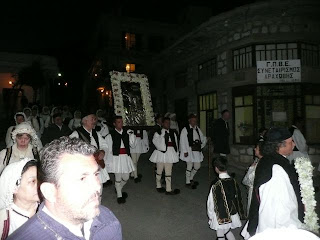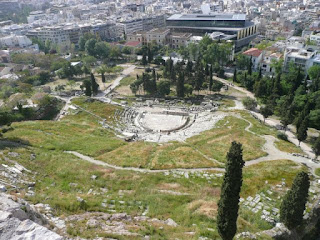Tuesday morning we loaded the bus for the drive to Athens. We were on the road a good three hours, again with some breaks. It’s odd to see huge, six-lane motorways with hardly any traffic. But with more than 20% unemployment and $10/gallon gasoline, Greek drivers aren’t as numerous as one might expect. Even the traffic in Athens is not too terrible.
 |
| Hadrian's Gate in Athens |
We arrived at the Acropolis Museum about noon for time on our own. Mary and I walked to Hadrian’s Gate and the ruins of the Temple of Zeus. Then we returned to the Acropolis Museum and spent a couple of hours there.
 |
| Temple of Olympian Zeus, Athens |
Our hotel was perched a good ways up Mount Lycabettus, the highest hill in Athens. It has a restaurant on the top floor with an excellent view of the city. After our farewell dinner at a restaurant across town, we went up to see the view of the city at night, before retiring to our rooms.
 |
| Long lens view of Acropolis from Mt. Lycabettus |
Fortunately, we did not have to join most in our group for a 3 a.m. ride to the airport to catch a plane back to the U.S. Instead, we elected an extra day on our own, and enjoyed breakfast up on the top floor. The day was bright and cloudless, and the morning light on the Acropolis was stunning from here. But we changed hotels for our second night as, once our tour ended, they wanted way too much for the room.
 |
| Breakfast view from the hotel. |
The Metro was not difficult to figure out, and it was only three stops to our new hotel, which we found without difficulty. The new room was old and not deluxe, but every bit as serviceable as that at the expensive hotel.
 |
| Library of Hadrian, Athens |
On our own we visited the Library of Hadrian, which was a huge place housing 17,000 scrolls in its day. Then we negotiated a few blocks of old city streets to reach the ruins of the ancient Agora. The Agora consisted of several “stoa,” or pavilions, for shops or traders. These were long and narrow, under roof, supported by columns. One has been rebuilt as a museum. Of the others, only the bases of columns remain.
 |
| Reconstructed stoa in the Agora of Athens |
One temple, the Temple of Hephaestus, remains mostly intact. Other temples, altars, and monuments are ruins – Ephesus provided a better picture of what it probably looked like. At the south end is Mars Hill, where according to Acts, St. Paul preached a famous sermon. We skipped it. I’m sure we were in the footsteps of Paul all over the Agora.
 |
| Agora with Temple of Hephaestus in the distance. |
We left this site to find the Roman Agora, an expansion of the area that was built in Roman times to accommodate expanding trade. This area was smaller but somewhat better preserved, especially the “Tower of the Winds,” a time-keeping observatory, at one end.
 |
| Temple of Hephaestus |
By this time the sun was getting hot, and we’d had enough old stones, so we made our way back to the Metro station to head for the Archaeological Museum. The Museum is actually within walking distance of our new hotel, but were a bit surprised to see that it closed early, at 3 p.m. As it was already 1:30, we were almost ready to come back tomorrow, but the clerk said we could buy a ticket today and come back tomorrow at no extra cost. So in we went.
 |
| Roman Agora, Athens |
Some of the most rare pieces in the museum are right on the ground floor. Mycean-era pottery and jewelry from around 5,000 BCE was breathtaking. Going farther, we saw some statues from the Classical period (ca. 500 BCE) that were remarkably preserved, even with the paint colors still quite visible, and the fine detail of the workmanship exquisite.
 |
Famous statue of Hercules,
Archaeological Museum of Greece |
When we returned the next morning, we had the place almost to ourselves until around 9:30 a.m., when the hordes from the cruise ships and the school groups descended. We saw as much as we could, but after awhile, one clay pot starts to look like another, even if they ARE 2,500 years old.
 |
Statue of a goddess. The delicate patterns
and remnants of paint in her dress are still
visible after nearly 3,000 years! |
One exhibit stood out, however. It was a featured temporary exhibit, that had just opened, of The Antikythera Shipwreck. This was a wreck discovered by sponge divers in 1900 off the coast of the small island of Antikythera. Some artifacts were raised in 1900-1901. Then, Jacque Cousteau went back in 1976 to uncover more.
The ship dates from 60-50 BCE, and it was laden with tons of luxury items: sculpture, glassware, jewelry, and other artworks. It truly was a treasure ship! Portions of statues left exposed to sea water were rather badly corroded, but those buried in the silt were exquisitely preserved. Some statues were partially buried, and therefore are partly damaged and partly pristine, making for an interesting effect.
 |
| Portions of the Antikythera Mechanism |
As if that were not enough, also discovered was The Antikythera Mechanism – the earliest preserved portable, mechanical astronomical calculator (sometimes referred to as "the world's first computer"). Only recently, with the advent of CAT x-ray technology, have the corroded gears and dials been fully analyzed and reproduced.
It displayed the positions of the Sun and Moon, lunar phases, and the positions of the five planets visible to the naked eye in the night sky, over a period of years. By turning a crank, any date in the past or future, within the 20 year range, could be selected, and the planetary information displayed for that day.
 |
| Scientists' reconstruction of the Mechanism. |
Apparently, this ship was equipped with the latest GPS technology of its time! And remarkably, the extent of this navigational information was greater than was commonly thought to have been available to seafarers of that day. Unfortunately, it must not have saved this treasure ship from its fate.
Having had enough museum, we walked back to the hotel at a leisurely pace, gathered our things, checked out, and walked up the street toward the Metro station. Before continuing underground, we stopped at another café for our last cheese pie while in Greece, and did some people-watching as we ate an outdoor table.
 |
| Digs at and under the Acropolis Museum |
The flight was on time, with great views of Greece, and later of Venice and the Alps. It was smooth until final approach to Gatwick, where high winds made for a lot of bumps. We had plenty of time to get to our 7 p.m. bus to Nottingham. That, too, arrived ahead of schedule, so even after a 10 minute wait for the local bus, we still arrived home before 10:30.























































